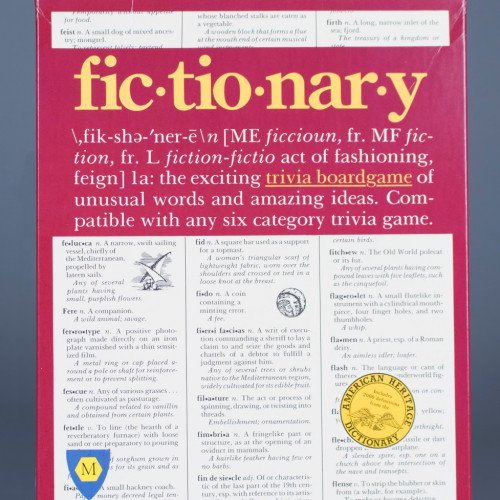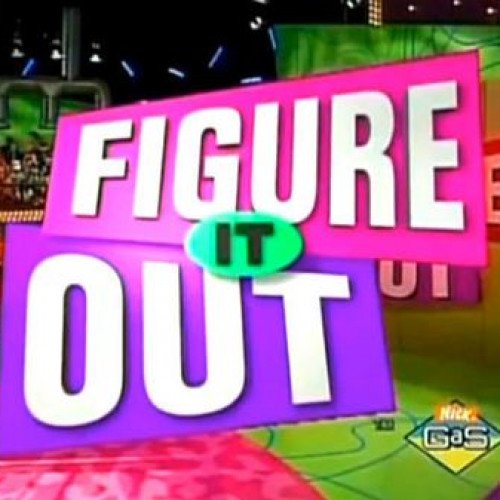"FICTIONARY" vs "FIGURE IT OUT"

FICTIONARY
Fictionary, also known as The Dictionary Game or simply Dictionary, is a word game in which players guess the definition of an obscure word. Each round consists of one player selecting and announcing a word from the dictionary, and other players composing a fake definition for it. The definitions, as well as the correct definition, are collected blindly by the selector and read aloud, and players vote on which definition they believe to be correct. Points are awarded for correct guesses, and for having a fake definition guessed by another player. The game requires a large and preferably unabridged dictionary, a pencil, pen or other writing implement for each player, and notecards or identical pieces of paper for each player. Individual house rules may vary when playing Fictionary, but play usually proceeds like this: One player, the "picker" for the turn, chooses an obscure word from the dictionary and announces and spells it to the other players. The chosen word should be one that the picker expects no other player to know. If a player is familiar with the chosen word, they should say so and the picker should choose a different word. If a word has more than one definition listed, the Picker privately chooses which one to use, but in such a case must specify, "X, when it does not mean so-and-so." Generally, the Picker can edit the dictionary definition as they desire. Each player writes a crafty and credible definition of the word, initials it, and submits it to the word picker. The Picker collects and shuffles the definitions, including their own, which is the correct one. As definitions are handed in, the picker should check them over to ensure that they can read the handwriting and to clarify any questions. Stumbling over or misreading a definition is usually a sign that it is not the correct one—unless the picker is trying to bluff. Once all definitions have been handed in, the picker reads the list aloud, once. On the second reading, each other player in turn then votes for the definition they believe is correct. Because the picker selected the word and knows the definition, the picker does not vote. Players earn one point for voting for the correct definition, and one point for each vote cast for the definition they wrote. (Other traditions for scoring award more points for guessing the correct definition than a player gets for picking their own.) The Picker earns three points if no one selects the correct definition. There are variations where the picker earns no points during their round as picker, fairness being achieved by ensuring that all players take equal numbers of turns as picker. Play then proceeds with the dictionary going to another player, which starts a new turn. A full circuit of the dictionary constitutes a round. One variation allows a player to vote for their own definition, although they do not get points for doing so. (This can encourage other people to vote for that definition as well, and the player would get those points.) Another variation does not allow a player to vote for their own definition.
Statistics for this Xoptio

FIGURE IT OUT
The Figure It Out board game was based on the popular children's game show Figure It Out on Nickelodeon. It was produced by Cardinal Games in 1998 and included a Billy the Answer Head board that was coated to allow for writing and erasing with crayon, two sets of game cards, and a timer. One player is designated as the contestant. The other player(s) are designated as the panel. The contestant picks an Answer card without revealing it to the panel. The number of words in the answer is revealed to the panel. Any words in parenthesis are written on Billy the Answer Head before the time begins. The timer is turned completely counterclockwise and started. During the timed interval, panel members ask 'yes' or 'no' questions. The same panelist continues asking questions until a question is answered 'no', at which point the next panelist begins asking questions. If a panelist says a word that is part of the answer, the timer is stopped, the word is written on Billy the Answer Head, and then the timer (and questions) resume. If, at the end of the round, the complete answer has not been discovered, the contestant selects a card from the First Round Prize deck. At the beginning of the second round, the contestant reads the first verbal clue. The timer is turned completely counterclockwise and started. The timed interval continues the same as during the first round. If, at the end of the round, the complete answer has not been discovered, the contestant selects a card from the Second Round Prize deck. At the beginning of the third round, the contestant reads the second verbal clue. The timer is turned completely counterclockwise and started. The timed interval continues the same as during the first two rounds. If, at the end of the round, the complete answer has not been discovered, the game enters the charade round. During the charade round the timer is turned completely counterclockwise and started. During the timed interval the contestant acts out the Charade Clue (marked with an asterisk (*) on the Answer card.) During this time the panel uses this clue to try to guess answer. If the answer has not been guessed by the end of this round, the contestant wins and draws a card from the Grand Prize deck. The roll of contestant then moves on to the next player.